
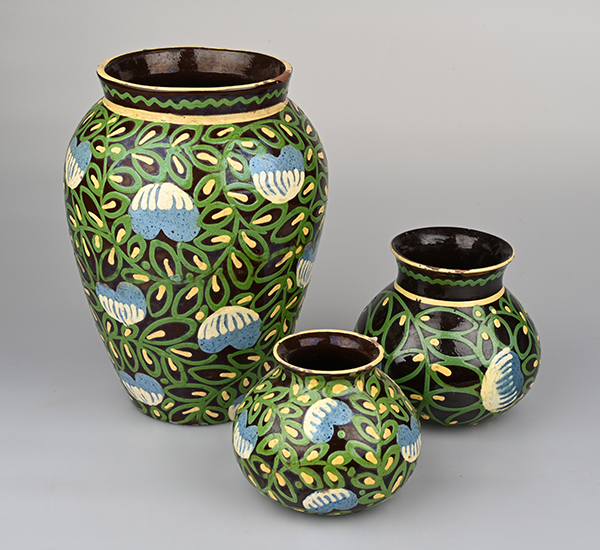
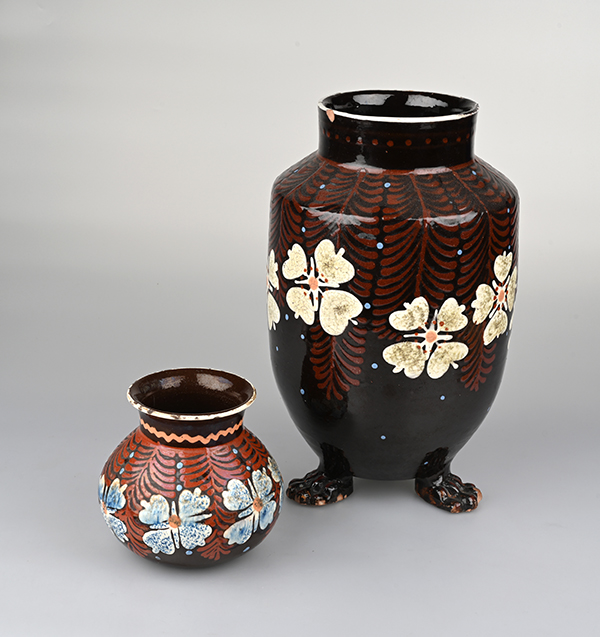
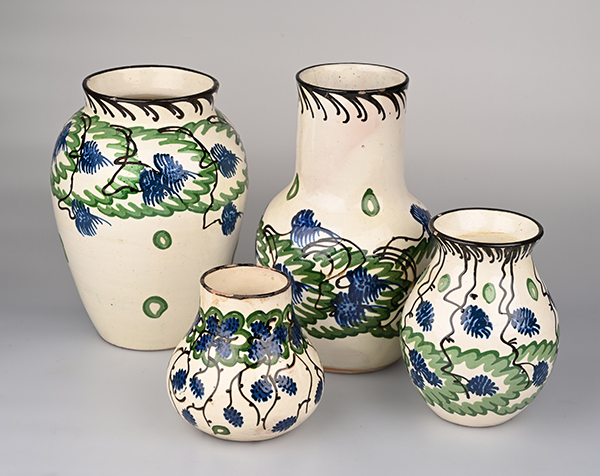
Pottery by DESA, c. 1916-1920
Andreas Heege, Andreas Kistler, 2023
Pottery by Desa in CERAMICA CH
The company name Desa (or DESA) is derived from the name of the Desalmand family of merchants in Bienne. The company existed from 1916 to 1952 at 167 Bernstrasse in Steffisburg. Along with the companies that succeeded Johannes Wanzenried’s manufactory (Loder/Schweizer and Adolf Schweizer), DESA was one of the main pottery producers in the Heimberg-Steffisburg region. A comprehensive overview of the firm’s range of products is still outstanding.
On 11th May 1915, the Steffisburg potter Karl Loder-Eyer (1871–1915) died at his workshop at 167 Alte Bernstrasse. Because he had no children, he had already appointed his three nephews, Emil Hermann Loder (1890–1971), Ernst Robert Loder (1891–1969) and Walter Loder (1882–1930), as heirs of his workshop and another property at 171 Alte Bernstrasse on 22nd December 1911 (see the Loder family tree). In 1911, Walter Loder was working for his uncle as a farmhand, Emil Loder as a pottery painter and Robert Loder as a potter in Wimmis (archive of M. Loder, Ebikon). The will was read on 20th May 1915, and when it was not contested, was declared valid by the Municipal Council of Steffisburg on 20th November (archive of M. Loder, Ebikon). On 12th November 1915, the heirs had already reached an agreement with Karl’s widow Anna Loder-Eyer, according to which she would buy them out of their entire inheritance, and they would divide the resulting assets amongst themselves as part of the definitive division of the estate (GB ThunBel. I 2880, 2881). The Swiss Official Gazette of Commerce announced the closing of the company “Kunsttöpferei Karl Loder-Eyer” on 28th December 1915 (SOGC 33, 1915, 1763), even though it had only just taken part in the Schweizerwoche [Swiss Week] in October (NZZ 21st October 1915) and had registered a list of 14 patterns for ceramic wares in the Swiss Official Gazette of Commerce on 1st December 1915 (SOGC 33, 1915, 1732).
A new cooperative had already been established on 13th September 1915 under the name “Kunsttöpferei Steffisburg vormals Karl Loder-Eyer” (Steffisburg Art Pottery formerly Karl Loder-Eyer). On 18th January 1916, it was registered in the Gazette of Commerce under the name “Kunsttöpferei Steffisburg vormals Karl Loder-Eyer – Poterie artistique de Steffisbourg, ci-devant Loder-Eyer” (SOGC 34, 1916, 91). The purpose of the cooperative was listed as follows: “… to maintain and promote the indigenous production of art pottery”, for instance by “… a. Taking over and continuing to run the pottery business set up by the late Karl Loder-Eyer in Steffisburg-Station; b. Producing and selling ceramic wares of all kinds, including the so-called Heimberg majolica…”. Anyone who was willing to purchase a share worth 500 Swiss francs could become a member of the cooperative. The organs of the cooperative were the General Meeting, a Board of Directors consisting of three to five members who were elected every three years, and a Board of Control. The founding Board of Directors had the following members: “Oskar Christener from Bowil and Zäziwil, businessman in Bern, President; Gustav Speckert, from Full (Canton of Aargau), businessman in Bienne, Vice President; Werner Schüpbach, President of the Municipal Council, from and in Steffisburg, Secretary; Emil Desalmand, from Geneva, businessman in Bienne; Georg Sibler from Zurich, businessman in Zurich. The business premises were located on Bernstrasse in Steffisburg-Station”. The founding of the cooperative was announced in various newspapers, including the Oberländer Tagblatt (Issue 40, No. 17, 21st January 1916), in the Geschäftsblatt für den oberen Teil des Kantons Bern (Issue 63, No. 10, 24th January 1916), in the Neue Zürcher Zeitung (NZZ 20/1/1916) and in the Keramische Rundschau (Issue. 24, No. 5, 1916, 32).
All of this leads us to assume that Karl Loder-Eyer’s workshop continued to operate after his death. Initially the cooperative leased the premises (GB Thun Bel. I, 4118). Adolf Schweizer (1893-1967), who had just graduated from the School of Ceramics in Bern, became its first director of operations (see Schweizer’s obituary in the Thuner Tagblatt 91, Number 288 dated 8th December 1967).
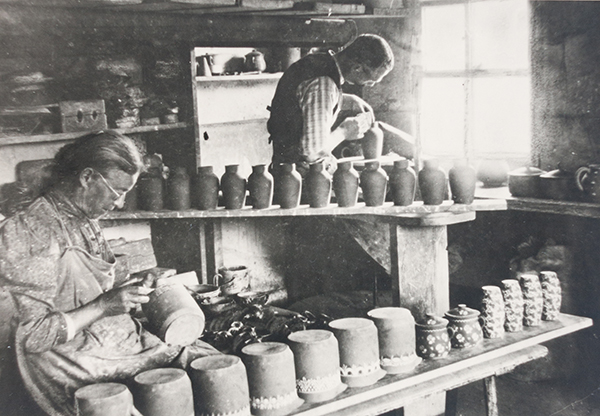
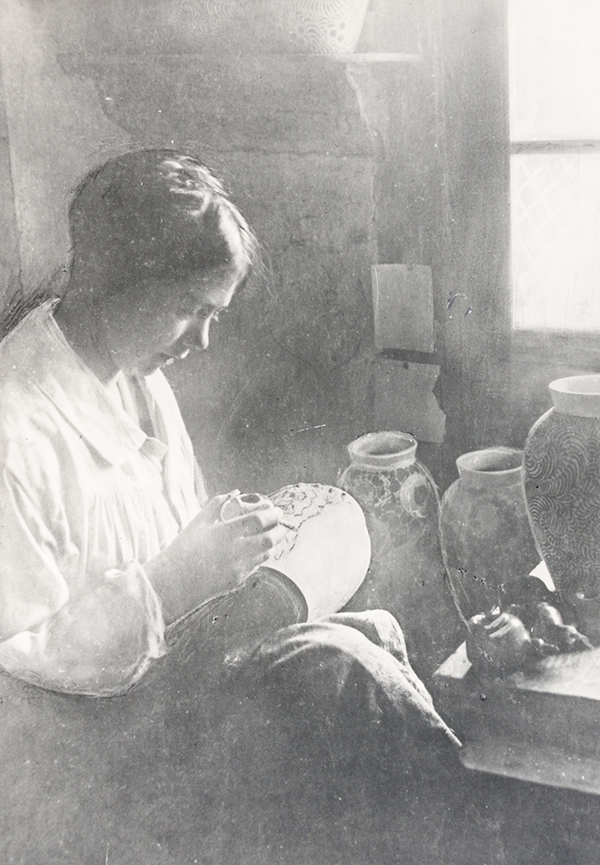
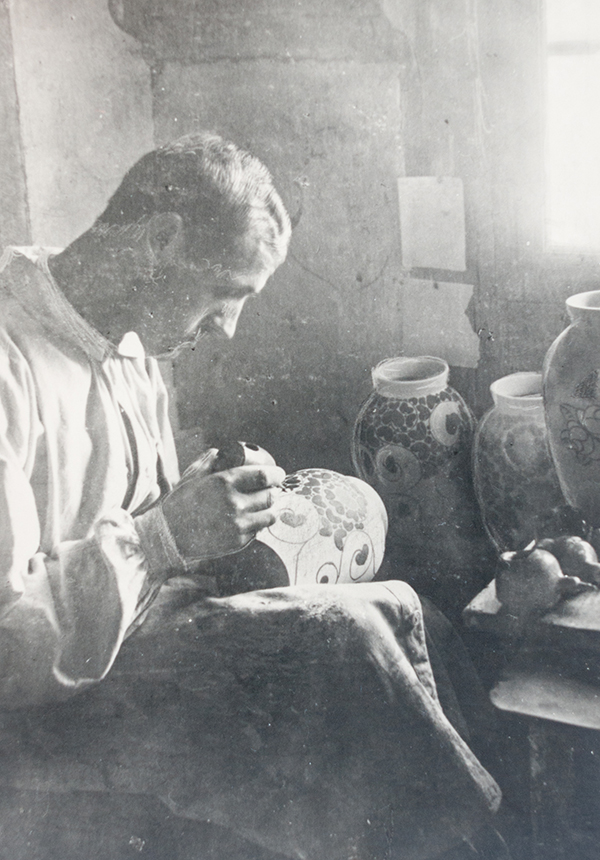
Workshop impressions, photos taken by Hermann Studer at the “Steffisburg Art Pottery, formerly Karl Loder-Eyer” in 1917.
It is not clear, however, who designed the new decorative patterns and who was employed there as throwers or pottery paintresses. It is also not certain which factory mark was used after the takeover. The precise range of products is unknown, though larger collections in private ownership or museums such as the Thun Castle Museum contain Bernese “Art Nouveau pottery” that seamlessly continued on from Karl Loder-Eyer’s style. We can therefore assume that the same paintresses continued to be employed by the company.
Karl’s widow, Anna Loder-Eyer, ultimately sold the workshop including all its assets and liabilities to the cooperative “Steffisburg Art Pottery formerly Karl Loder-Eyer” on 1st May 1917 (GB Thun Bel. I, 4118).
In 1917, the Steffisburg Art Pottery took part in the “Christmas Exhibition of Swiss Arts and Crafts” in Zurich (Der BUND 68, No. 481, 14th October 1917).
The next mention of the company dates from 1917/1918. At that time, the BUND newspaper (68, No. 185, 22nd April 1917) and the Oberländer Tagblatt (42, No. 102, 3rd May 1918) reported that the Steffisburg Arts Pottery was one of the companies from the Oberland region exhibiting at the Schweizerische Mustermesse fair in Basel (MUBA). From then until 1941 the company would be represented at the MUBA almost every year (except for 1936-1937; see the official MUBA catalogue). The 25th anniversary of its participation in 1941 was explicitly acknowledged (not quite correctly) by a congratulatory advertisement in the Swiss Official Gazette of Commerce (28th April 1941, SOGC 59, No. 98, 824).
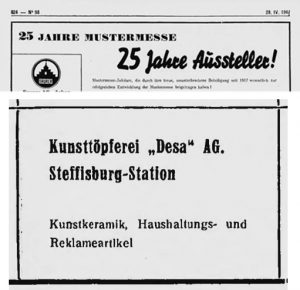
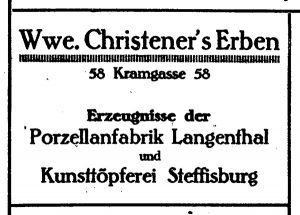
In 1918, the company again took part in “Swiss Week” and exhibited its wares at the business premises of the widow Christener’s heirs on Kramgasse in Bern (Der BUND 69, Number 424, 4th October 1918).
On 2nd July 1919, the members of the cooperative voted to extend the property by purchasing a garden plot of 311 square metres from Anna Loder-Eyer (GB Thun, Bel. II, 1298). The plan was to extend the factory space to the designs of an engineer called Keller from Bern. The space was to accommodate two new potters’ kilns.
An important step in terms of the organisation of the company was the election on 19th November 1919, of artillery officer Gustav Joseph Desalmand (1894–1980) as managing director of the cooperative with full authority to represent the company (SOGC 37, No. 267, 1954; see the article on his 80th Birthday in the Thuner Tagblatt 98, No. 221, 21st September 1974 and his obituary in the Thuner Tagblatt 104, No. 220, 19th September 1980).
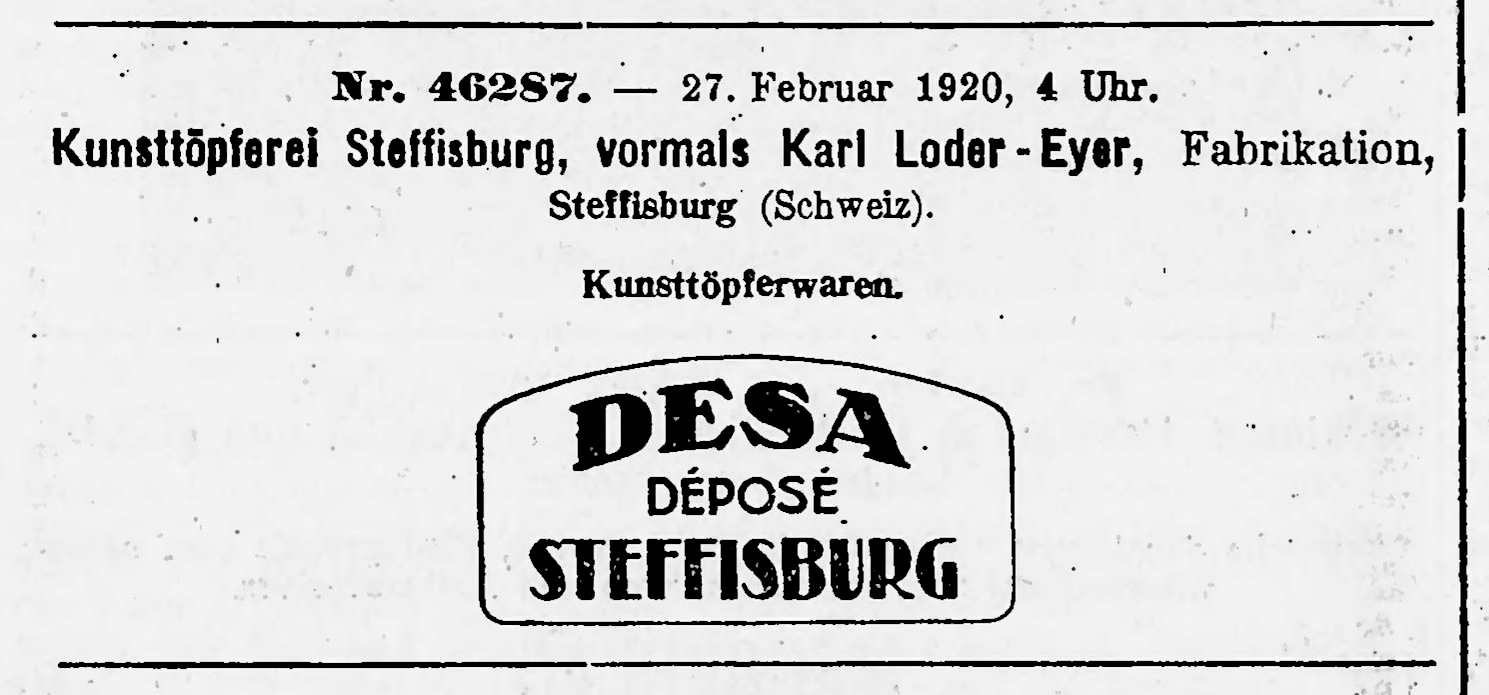
On 27th February 1920, the cooperative had its first mark registered in the Swiss Official Gazette of Commerce (SOGC 38, 1920, 434). Despite the fact that the identifier “DESA” was not officially added to the company name until 1926 (SOGC 45, No. 222, 1693, 21/9/1927), the mark that was registered in 1920, already included it. We can probably assume that the earlier production line from 1916 to 1919 also carried the label “DESA/Desa” in a bid to make it clear who the cooperative’s main men were.
In October 1921, the Schweizer Illustrierte Zeitung ran an illustrated story (cf. a report in the Oberländer Tagblatt 45, No. 249, 24/10/1921), which gives us an insight into what the workshop and the production line for that year looked like. As well as floral Art Nouveau motifs, the earlier Chrutmuster herbal pattern from the Thun majolica period continued to be produced.


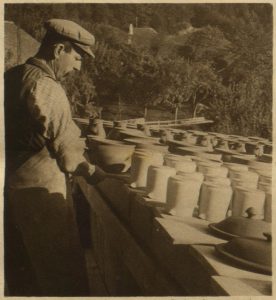
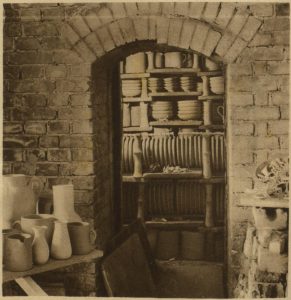
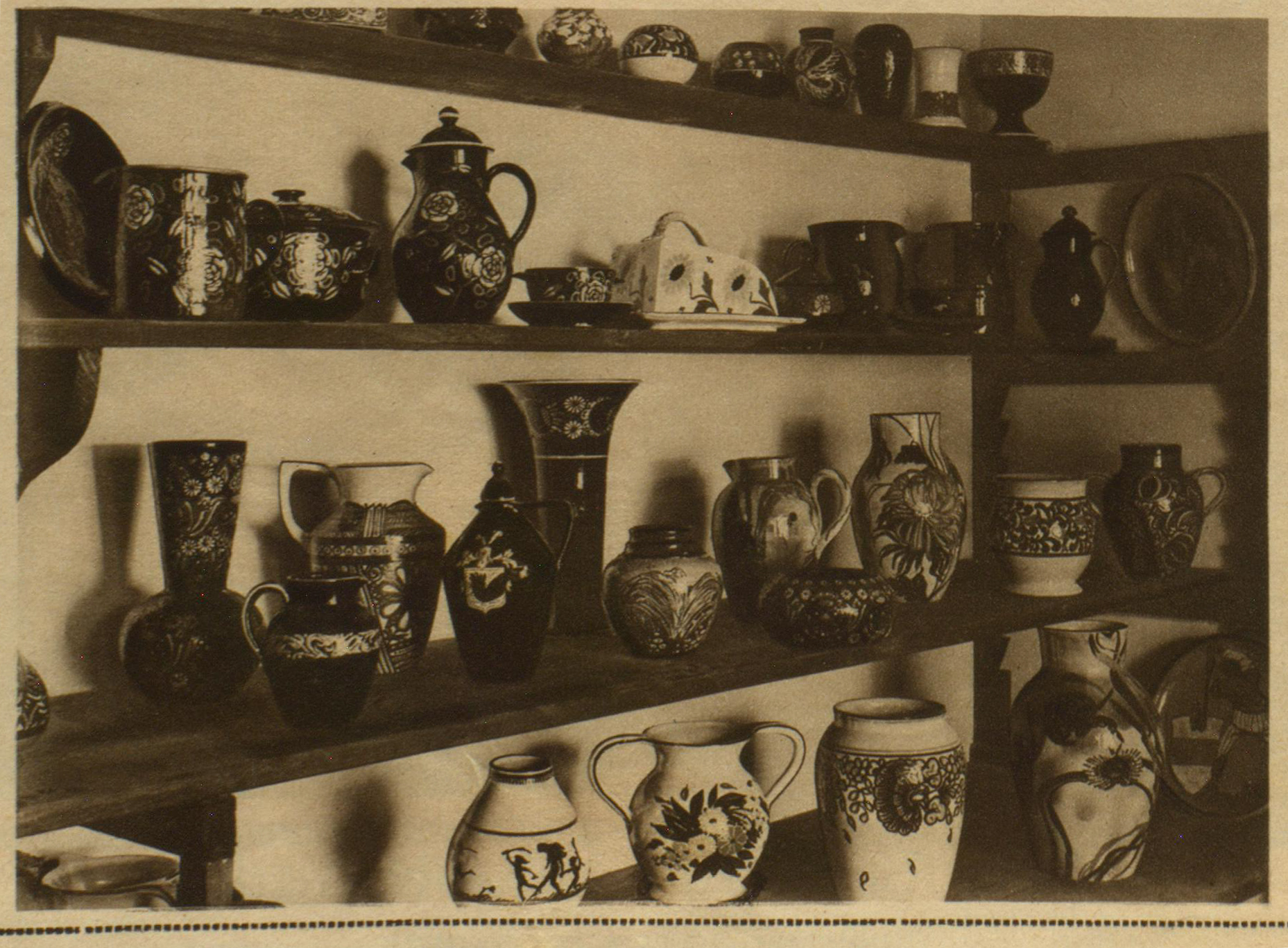
Schweizer Illustrierte Zeitung 1921, the Steffisburg Art Pottery, Desa.
In December 1921, templates for art pottery patterns (“viticultural scenes”) were registered and published in the Swiss Official Gazette of Commerce (SOGC 40, 1922, 395). A further eleven patterns followed in 1923 (SOGC 41, 1923, 1264) and were subsequently extended under the number 35205 for another five years in 1928 and again in 1933 (SOGC 46, 1928, 1854; 51, 1933, 2285).
In May 1922, the Steffisburg Art Pottery published a job advertisement for an “skilful woman” for the casting department (Oberländer Tagblatt 46, No. 111, 13/5/1922), which had obviously grown in importance compared to the throwing department.

In 1922, Der BUND newspaper (73, No. 182, 1st May 1922) published a detailed report on the Steffisburg Art Pottery and the products it had exhibited at MUBA.
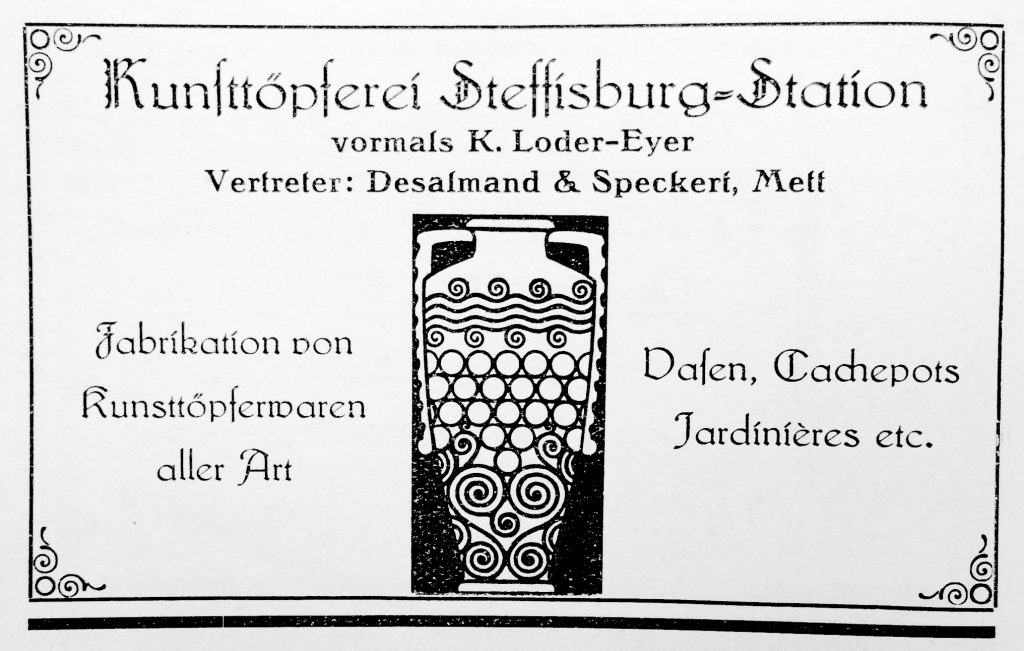
1922 advertisement (Town Archive of Thun).
An advertisement from 1922 in the catalogue of the “Handwerk, Gewerbe- und Industrieausstellung Thun und Umgebung” [trade, crafts and industry exhibition] from 29th July to 13th August 1922 (the original is kept at the Town Library of Thun) identifies the purpose of the company to “manufacture art pottery of all kinds, vases, cache-pots, planters etc.” and has an illustration of a pretty vase decorated in a style on the transition from Art Nouveau to the more geometric Art Deco.
In 1924, the Steffisburg Art Pottery, together with the Wächter-Reusser workshop in Feldmeilen, Bodmer&Cie in Zurich (ceramicists Luise Strasser and Bertha Tappolet) and Meister&Co. in Dübendorf, took part in a pottery exhibition curated by the Museum of Arts and Crafts in Zurich (NZZ 27/7/1924).
In 1924, a “flower vase with stem holder” was added to the register of patterns under the number 35989 (SOGC 42, 1924, 714) and extended for five years in 1929 and for another four years in 1934 (SOGC 47, 1929, 1026; 52, 1934, 1535).
In 1925, Desa produced a wall-mounted plate as an honorary gift to be presented at the Mittelländisches Schützenfest [a shooting festival] in Zollikofen (Bieler Tagblatt, No. 88, 17th April 1925).
On 31st December 1926, the General Meeting revised the statutes of the cooperative, fundamentally changing its ownership structure (SOGC 45, No. 222, 1693, 21/9/1927; see also the entry in the land register, Grundbuch Thun, Bel. II, 9682, 1927). The name was changed to “Desa Art Pottery Steffisburg-Station, formerly Loder-Eyer (Poterie artistique Desa Steffisbourg-Gare, ci-devant Loder-Eyer)”. The purpose of the cooperative was to “… carry out all business and artistic activities associated with the Art Pottery… The cooperative elects a Director who may also be the President of the Board of Directors. The Director is the sole approved signatory for the cooperative”. The former managing director, Joseph Desalmand, became the new Director/President. The former board members, Christener, Speckert, Schüpbach, Desalmand and Sibler resigned. Léon Desalmand, businessman from Bienne-Mett (10/7/1899-22/4/1967, president of the municipal council of Bienne in 1946/1947, local CSP councillor), was Vice President and Cécile Desalmand from Bienne-Mett was the Secretary. Clearly, the company was now firmly in the hands of the Desalmand family. The “Official Address Book of the Town of Thun and its environs” (1927, 258) ran an advertisement to announce the change in the company name.
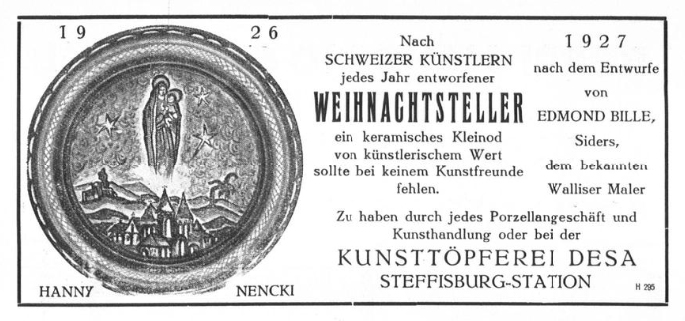
In 1926 and 1927, DESA, probably for the first time, created a series of Christmas plates. The plate for 1926 was designed by the ceramicist Hanny Krebs Nencki (1903–1986), the one for the following year, 1927, by the artist Edmond Bille (1878–1959) from Siders (Der Bund, Volume 78, No. 513, 24th November 1927). It remains unclear whether the series was a success and was continued. None of the original plates have so far come to light.
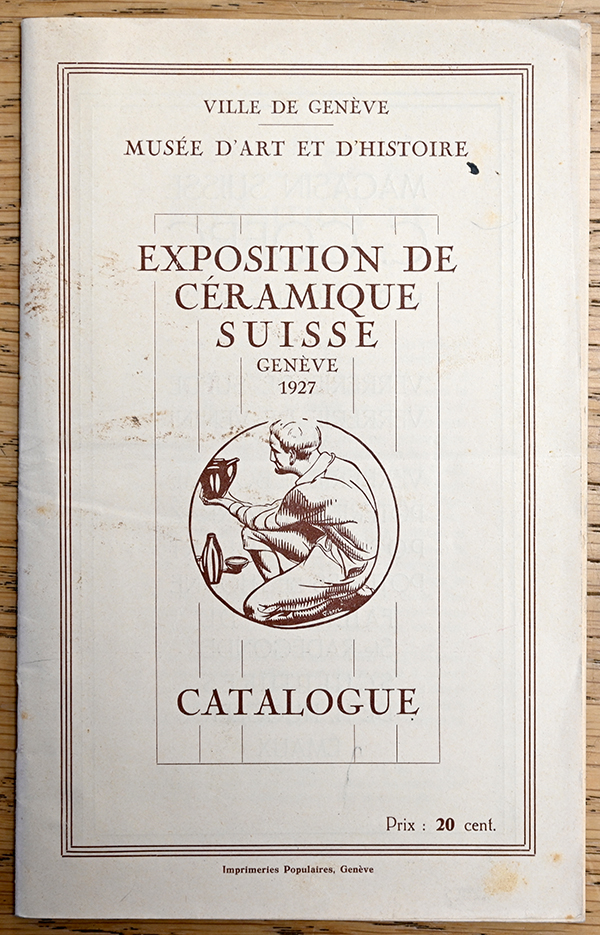
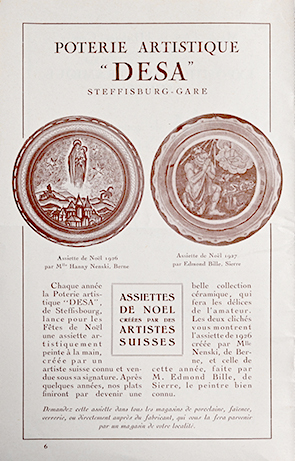
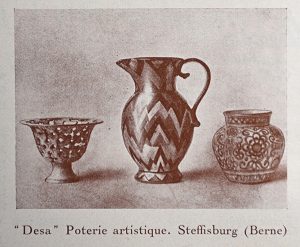
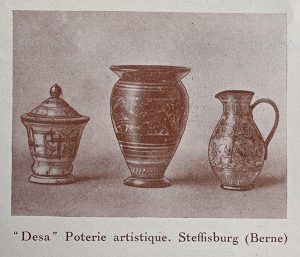
The production line for 1927 was presented at a large exhibition entitled “Céramiques Suisses” curated by the Museum of Art and History in Geneva. Der BUND reported in detail on the exhibition and the representatives from Bern (Der Bund, Volume 78, No. 395, 14th September 1927).
In 1928, DESA had its own stand at MUBA, next to Adolf Schweizer from Steffisburg who, by that time, had been running the old Wanzenried Manufactory for four years on his own (Oberländer Tagblatt 52, No. 92, 30th April 1928). The company also took part in SAFFA (Swiss Exhibition for Women’s Work) (Der Bund, Volume 79, 20th September 1928; Oberländer Tagblatt, Volume 52, No. 225, 25th September 1928).
That same year, DESA sponsored two plates as honorary prizes to be presented at the Swiss Sailing Championship Regatta on Lake Thun (Oberländer Tagblatt, Volume 52, No. 149, 28th June 1928).
1929 The company also took part in an exhibition for “Swiss Week” (an advertising campaign for Swiss work run since 1917) at the Freienhof in Thun (Oberländer Tagblatt 53, No. 252, 28/10/1929).
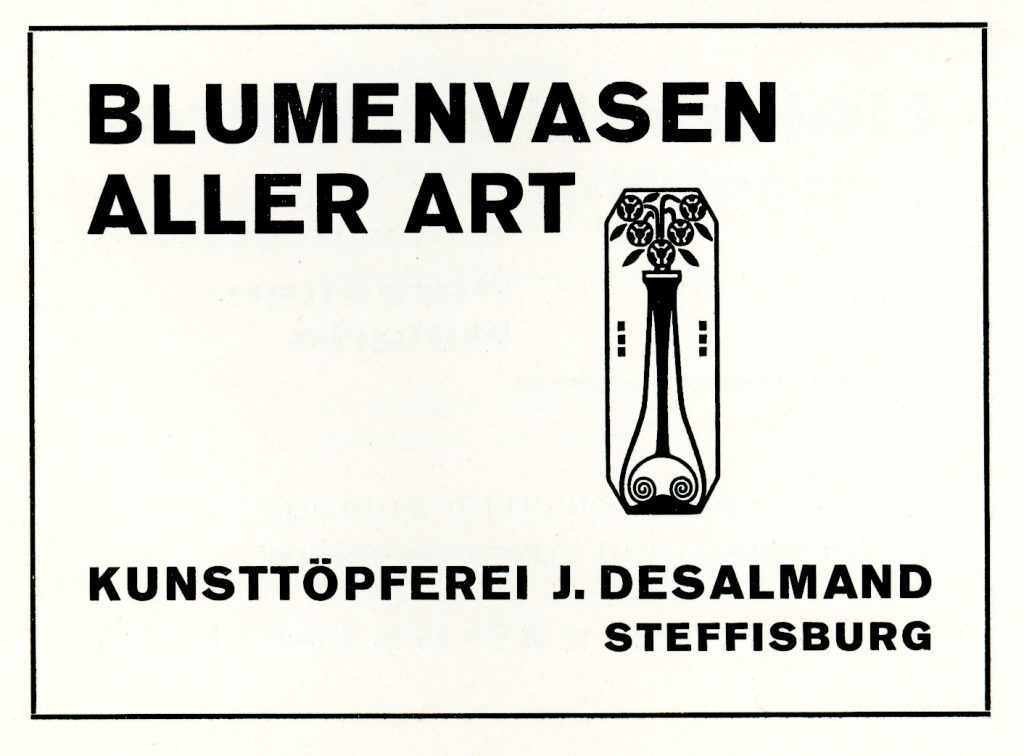
1930 A publication celebrating the “25th Anniversary of the School of Ceramics in Bern” (Haller 1930) included an advertisement for vases of all kinds made by the “J. Desalmand Art Pottery in Steffisburg”.
In 1932 DESA patented a humidifier under the number 50182 and extended the patent for another five years in 1938 (SOGC 50, 1932, No. 274, 2724; 561).
In 1932, DESA collaborated with the graphic designer, painter, caricaturist and artist Armin Bieber (1892-1970) to create a series of plates with amusing caricatures for the Swiss Gymnastics Festival in Aarau (on Armin Bieber see: Der Bund 5/6/1952, Neue Zürcher Zeitung 7/6/1962).
On 10th February 1933, the cooperative, including all its assets and liabilities, was converted into a limited company and renamed “Desa Art Pottery Limited Company – Poterie artistique Desa Société anonyme”. The cooperative had a share capital of 200.000 Swiss francs in 400 nominal shares at 500 francs each. The company board included Emil Desalmand from Bienne. Joseph Desalmand continued to act as Director and Managing Director (SOGC 51, No. 93, 972-973). The old cooperative was dissolved (SOGC 53, No. 226, 2406; see also the entry in the land register, Grundbuch Thun, Bel. III, 6147, 1935). On 30th November 1935 the company assets were reduced to 112,000 francs (SOGC 54, No. 13, 126).
In 1933, Desa donated a 16-piece breakfast service worth 28 Swiss francs to the Oberland Shooting Festival in Heimberg (Oberländer Tagblatt, Volume 57, No 79, 4th April 1933).
1934 As an artillery officer, Joseph Desalmand was a member of the Thun Officers’ Association. It is therefore no surprise that the association donated four “Desa vases” to the city of Bern to present to the top marksmen at the Swiss Shooting Festival in Fribourg (Die Berner Woche 1934, No. 29, 467).
In 1934, Steffisburg was represented at the “Bern Festival” parade by a group of potters (Geschäftsblatt für den oberen Teil des Kantons Bern, Volume 81, No. 73, 22nd June 1934).
In 1935, new designs for ashtrays and a “container for storing Schabziger [a type of Swiss whey cheese]” were registered under the number 54506 (SOGC 53, 1953, 1013).
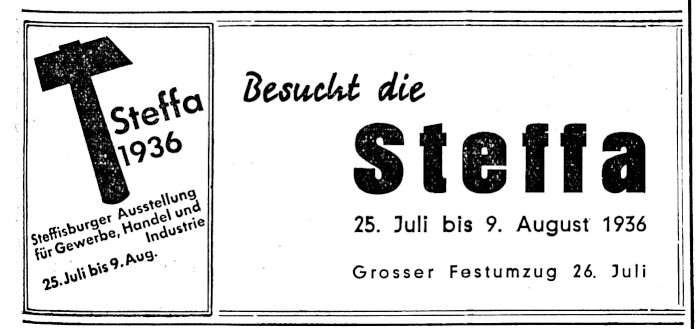
The “Steffa 1936” (Steffisburg Exhibition of Trade, Crafts and Industry) was held from 25th July to 9th August 1936. On the final day of the exhibition, the Oberländer Tagblatt (Issue 60, No. 179, 3rd August 1936) wrote: “Visitors obviously expect a good showing from the pottery producers, and they will not be disappointed. Even though not all of the enterprises take part in the “Steffa”, three of them are represented: Desa Art Pottery AG, Ad. Schweizer Art Pottery and Rob. Hänni. It is a joy to behold what their stands have to offer. Each of them has its own unique style; rich, deep colours at one stand, that make one feel as if one is looking into the vast winter sky in the gleaming mid-day sun; a more artistic approach to shape and colour at the next; and finally, modern refined white earthenware with a nod to the products of yesteryear at the third. In any case, our local potters have learnt a lot from their rivals. They have been forced to break the mould and find new avenues and they have made great progress in doing so. Let us hope that their vessels will win over many enthusiasts.”

Die dekorierte Thuner Reithalle 1937, Foto Archiv Stiftung Schloss Thun.
In 1937, Captain Joseph Desalmand made his staff available to decorate the walls of the Thun hippodrome with murals of equestrian and military scenes (Oberländer Tagblatt 61, No. 256, 2nd November 1937; also Henri Habegger, Die Fresken in der Reitbahn der Alten Pferderegie Thun und der „Besuch der alten Dame“, Info-Bulletin VSAM – Verein Schweizer Armeemuseum Nr. 1/ 11, 15-17 ). hey used the company’s own designs intended for wall-mounted plates based on templates from the Adolf Pochon collection (housed at the Swiss National Library since 1931 – A. Pochon/ A. Zesiger: Schweizer Militär vom Jahr 1700 bis auf die Neuzeit, Bern 1906) and from the works of the Austrian equestrian artist Ludwig Koch (1866–1934).
 Geschäftsblatt für den obern Teil des Kantons Bern, Band 84, Nummer 130, 8. November 1937
Geschäftsblatt für den obern Teil des Kantons Bern, Band 84, Nummer 130, 8. November 1937
After completion of the frescoes in 1937, ceramics bearing identical motifs were put on display in a shop run by the widow of J.R. Bähler on Hauptgasse lane in Thun and sold as souvenirs (Oberländer Tagblatt 61, No. 256, 2/11/1937).
1938 A report in the Berner Woche newspaper (Issue 28, No. 53, 1938, 1378-1383) by Walter Schweizer included photographs of DESA staff members at work. The images show DESA as a modern pottery producer.

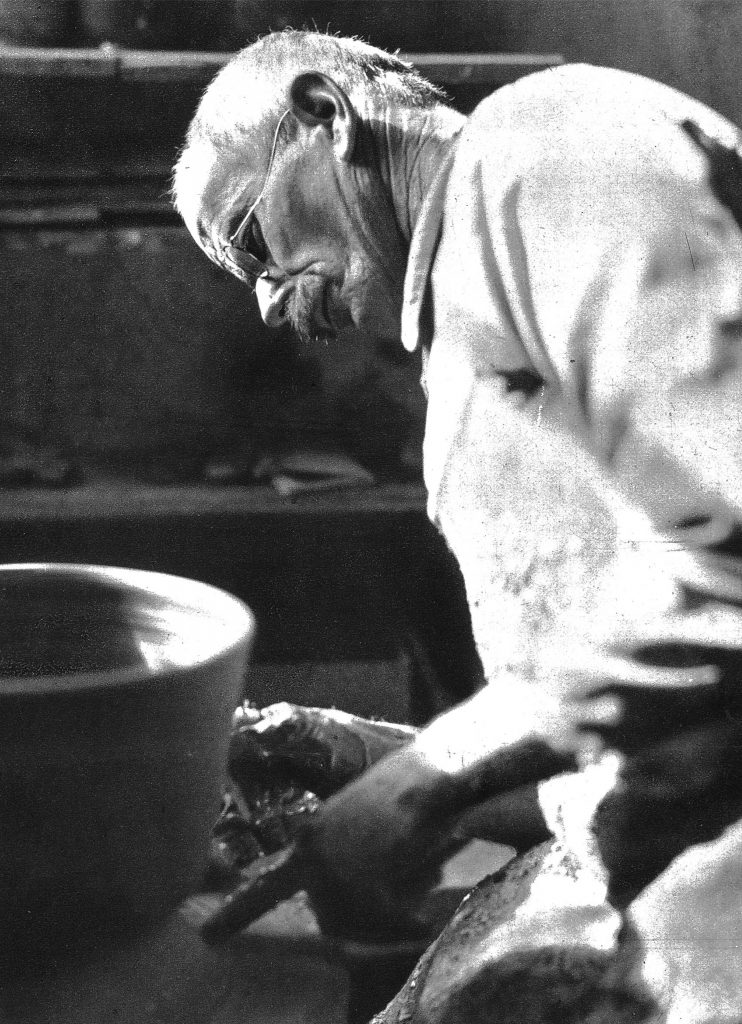
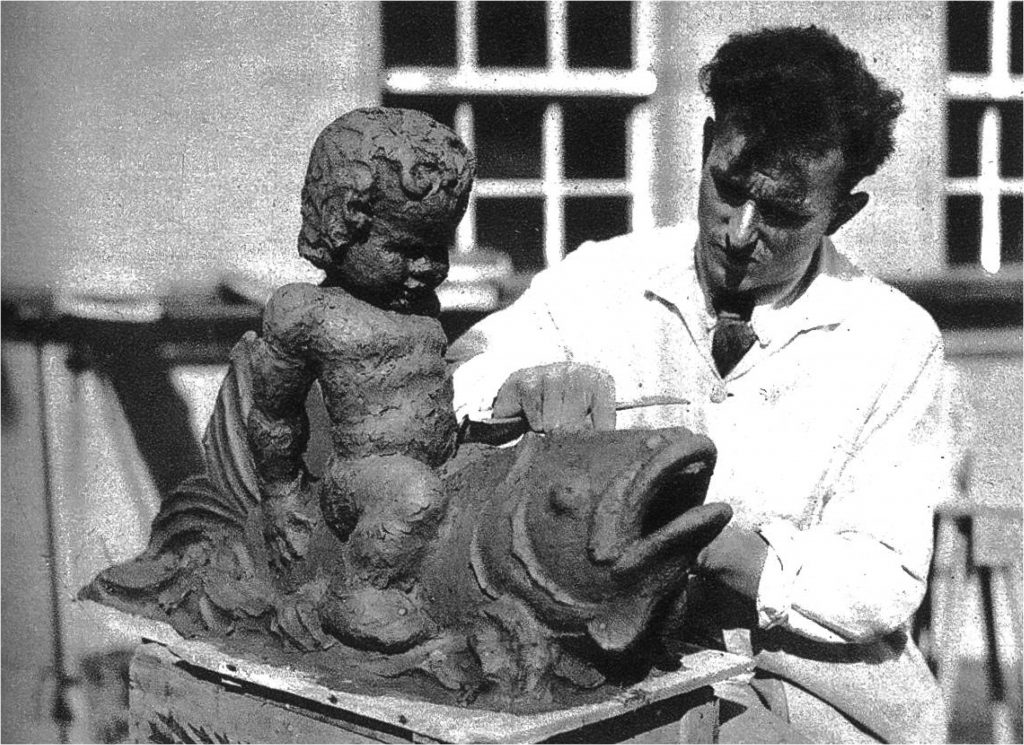
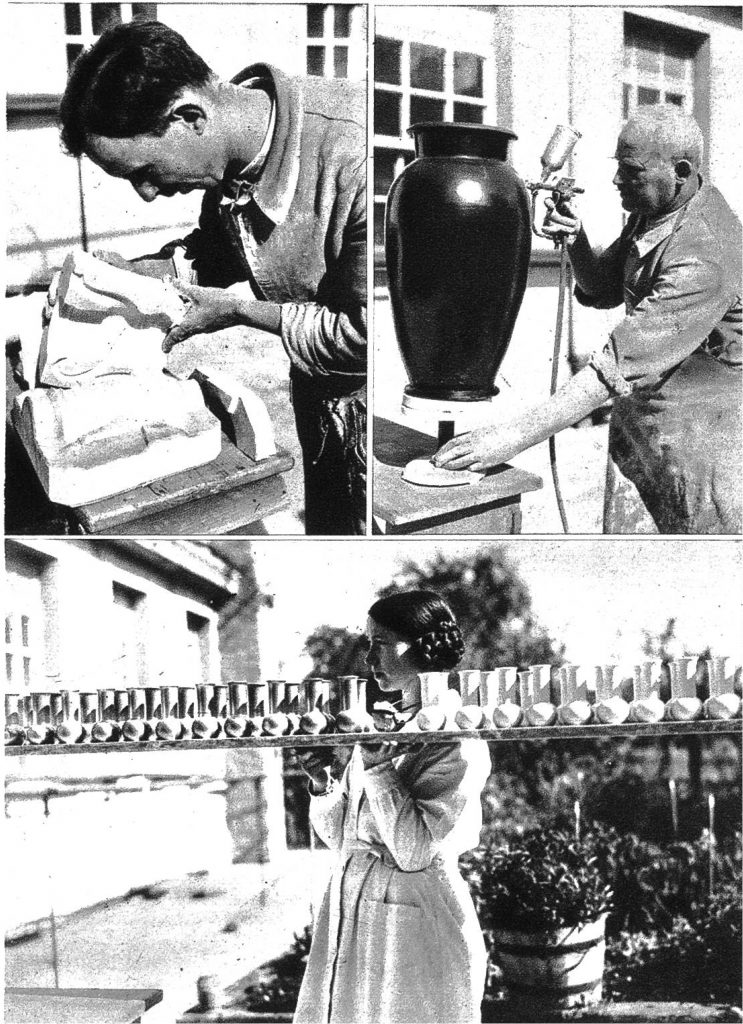
Desa in the “Berner Woche” newspaper in 1938 (photos by Walter Schweizer). The sculptor is “Mädi” Zünd, who also worked for a time at Kunstkeramik A.G. in Lucerne.
In der Firma wurde Keramik gedreht, eingedreht, gegossen und frei modelliert, Engoben und Glasuren wurden auch mit der Spritzpistole aufgetragen.

The decorations were applied by pottery paintresses, as can be seen from a contemporaneous brochure about Swiss pottery production (NN, Quelques industries d’art en Suisse, Lausanne : M. Steiger & Co., no date, 13).
In 1942, DESA created a plate to be presented as a travelling trophy at the Swiss Cross Country Championships (Der BUND, Volume 93, No. 149, 30th March 1942).
We get an even better impression from a illustrated story published in June 1943 in a special issue of the Berner Woche newspaper entitled “Thun and its industrial development”.
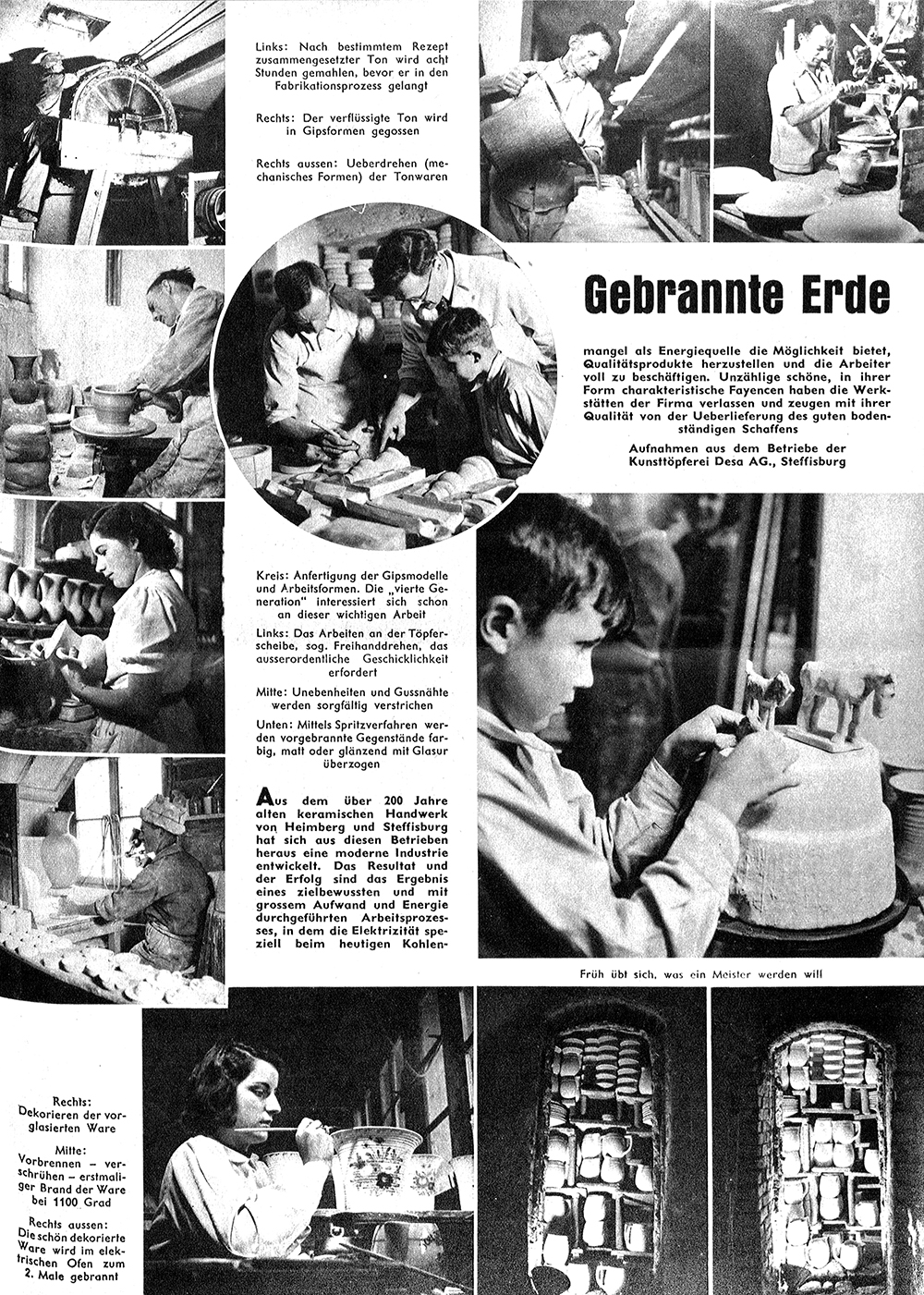
In 1944, DESA were commissioned to produce 400,000 “Beckeli” [small collection boxes in the shape of a cup or jug] for a fundraising drive on behalf of the Swiss Red Cross Children’s Aid (Bieler Tagblatt, No. 39, 16th February 1944).

Report on the Red Cross drive in the Oberländer Tagblatt 68, No. 38; 15/2/1944.
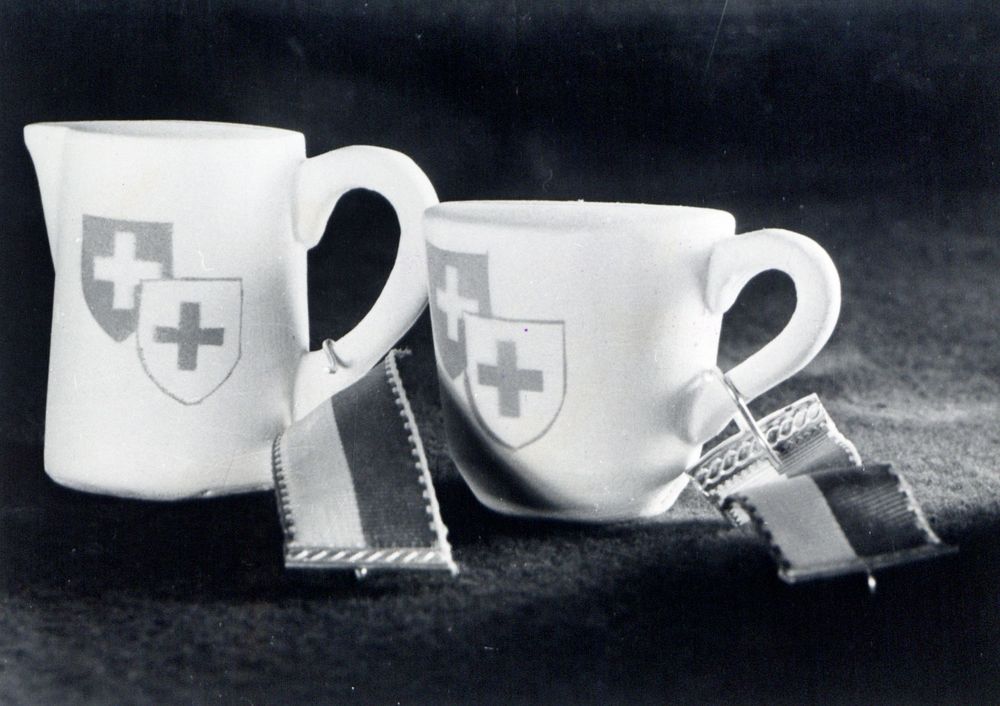
Collection boxes manufactured by Desa (photo Swiss Federal Archives Bundesarchiv Bern_csm_5.8.18_a22b99a7fe).
From 1944, the hardship endured by countries affected by the Second World War became increasingly severe, prompting the Swiss Red Cross Children’s Aid Fund to extend its involvement abroad. To meet the growing need for financial aid, the Red Cross had to find a new source of funding. This gave rise to the idea of selling small ceramic money boxes in the shape of milk jugs or cups. Once they were full, the children brought them to a Children’s Aid collection point.
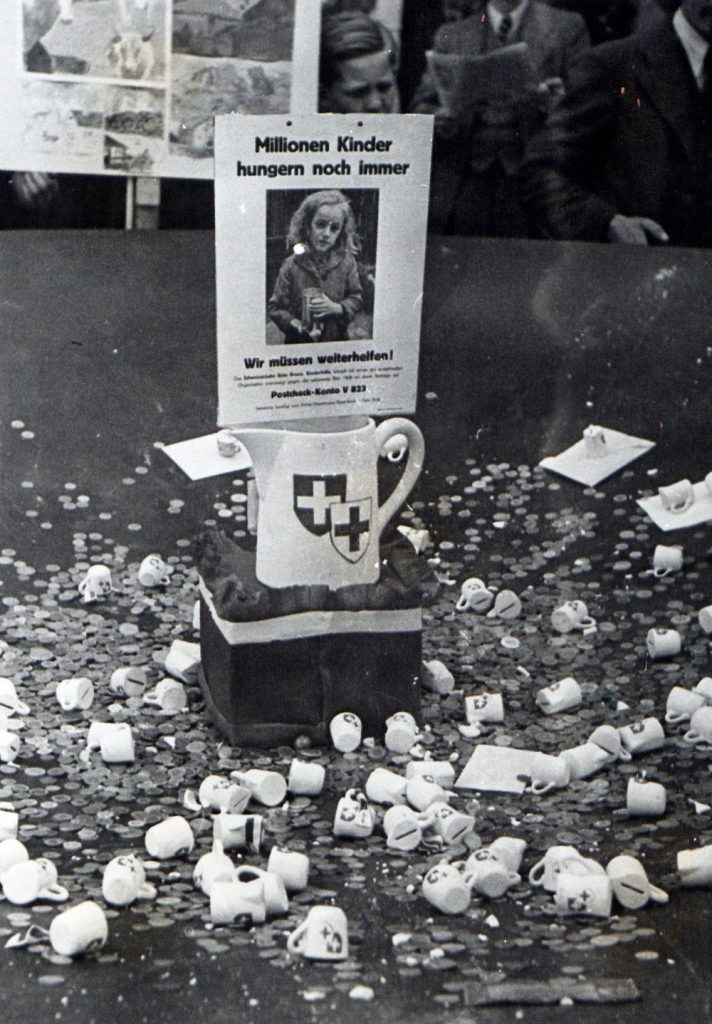
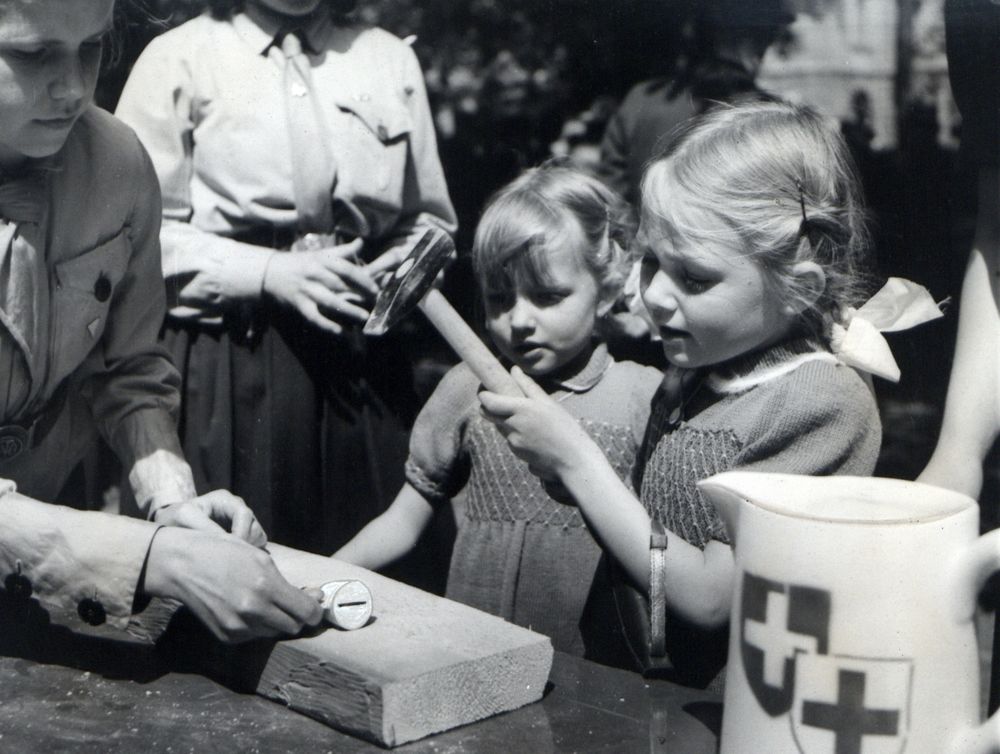
Photographs from the Swiss Federal Archives (Bundesarchiv Bern_csm_5.8.26_754_a2f324ee1f und Bundesarchiv Bern_csm_5.8.23_43bf029285).
Opening the money boxes involved smashing them with a hammer and this was usually accompanied by a funfair especially for children. This particular fundraiser became an instant success, both in cities and in rural areas. By the end of 1944, 469,935 collection boxes had been sold and 740,436 francs raised.
To mark the occasion, important Swiss media representatives were invited to visit Steffisburg and given a tour of the factory. Joseph Desalmand gave a lecture on the history of pottery production in Heimberg and Langnau, accompanied by a slide show by pottery instructor Geiser from Bern (Oberländer Tagblatt Issue 68, No. 38, 15th February 1944; NZZ, 14th February 1944).

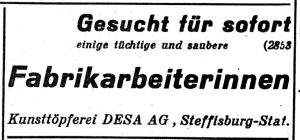
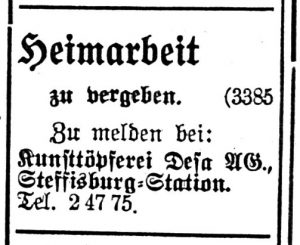

Job advertisements from 1945 and 1946.
The strong domestic economy in the final years of the war and the period just afterwards is reflected in job advertisements, mainly in the Oberländer Tagblatt newspaper, placed by DESA from 1944 to 1946 seeking workers or people to work from home (e.g. Oberländer Tagblatt Issue. 68, No. 304, 27/12/1944; Oberländer Tagblatt Issue 70, No. 235, 8/10/1946). On 29th March 1947, the department of the factory that housed the kilns went up in flames, but the electric kilns were left unscathed (Oberländer Tagblatt Issue 71, No. 74).
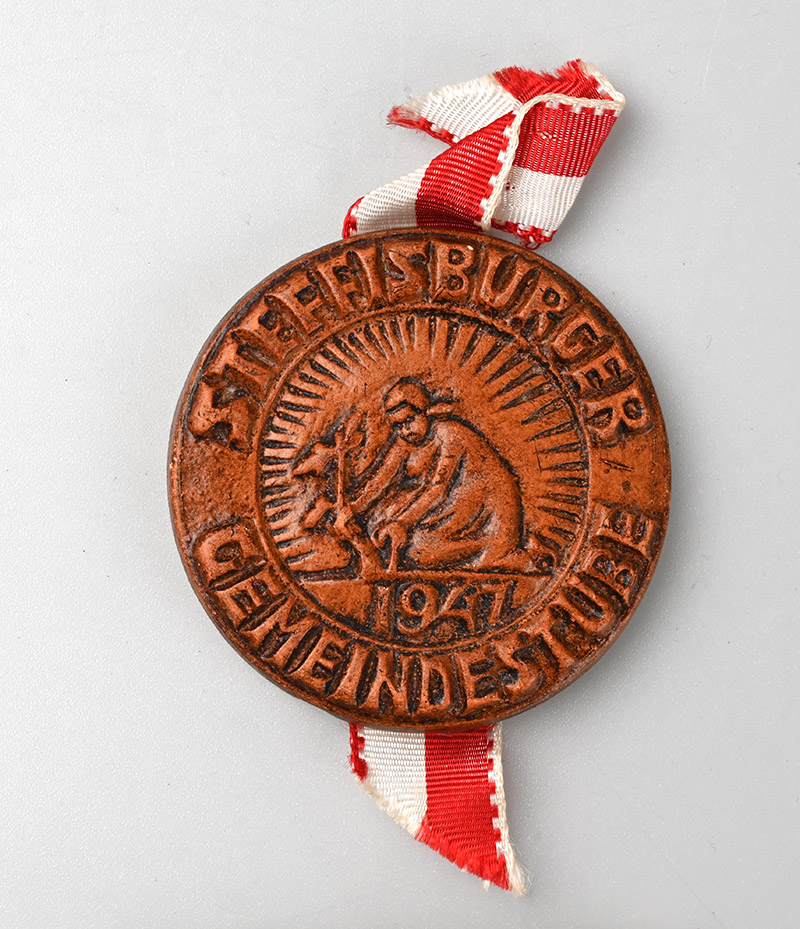
Following the example of other municipalities, the charitable women’s association of Steffisburg began to work towards setting up a “Gemeindestube”, a cross between a soup kitchen and a cultural community centre. In September 1947, the women’s association organised a bazaar to raise funds for the project, and in the week leading up to it, sold ceramic medallions designed by Ernst Schütz, a pottery painter from Steffisburg, and produced by DESA (personal communication from Georg Frank, Thun). Schütz was a DESA company employee.
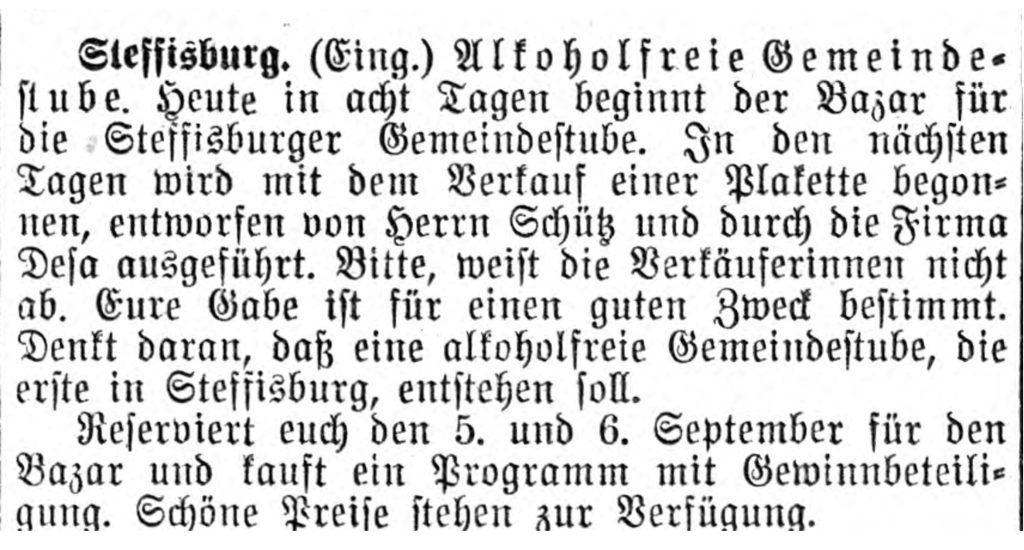
Berner Tagwacht newspaper, 29/08/1947.
The post-war economic boom, however, lasted only until the late 1940s. Why the company’s economic fortunes went into decline after that, is not known (perhaps they neglected to update their shapes and patterns, or perhaps there was not enough capital investment to pay for technical upgrades, or the buildings/property were not big enough?).
In November 1950 the company’s board of directors was restructured. It was now made up solely of members of the Desalmand family (Emil, Léon and Joseph), with 56-year-old Joseph Desalmand holding on to his post as President of the Board and Managing Director (SOGC 68, No. 278, 3035 and SOGC 69, No. 45, 470). By 1951, the company’s debts had risen to such an extent that the NZZ newspaper (28/11/1951) announced a moratorium on the definitive debt restructuring in the hope of avoiding bankruptcy. However, this did not have the desired effect and on 19th June 1952, the bankruptcy judge in Thun initiated proceedings (SOGC 70, No. 145, 1606) and by September 1952, a schedule of claims had been set up (SOGC 70, No. 209, 2222). Two properties and buildings owned by the company (Steffisburg, 167 Bernstrasse, plot numbers 629 and 628) were sold at auction on 8th December 1952 (SOGC 70, No. 263, 2735) and the bankruptcy proceedings were officially completed on 1st December 1953 (SOGC 71, No. 284, 2950). As part of the compulsory auction, the property had to be taken over by the municipal authorities of Steffisburg, who in 1954 sold it at a loss to a locksmith from Thun (Oberländer Tagblatt 78, No. 241, 15th October 1954).
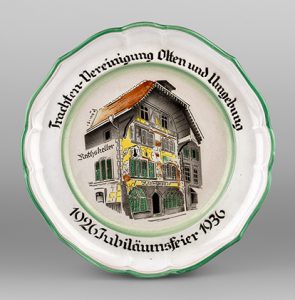
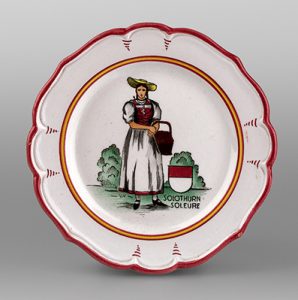
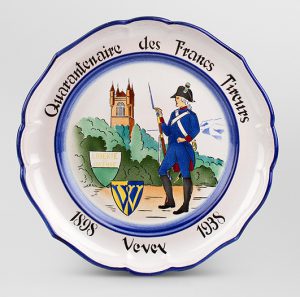
The range of pottery that was produced by DESA has never been comprehensively studied. Like all of the larger pottery producers in Switzerland, it too was commissioned on several occasions in the 1930s to manufacture significant amounts of commemorative objects and ceramics for various clubs and associations.
Bigger numbers of objects and a few archival records are housed at the Thun Castle Foundation but have not yet been analysed; others can be found at the Swiss National Museum in Zurich (e.g. LM-76758; LM-79033; LM-79034; LM-79557; LM-79583; LM-79584; LM-83670; LM-149604; LM-149605; LM-149606; LM-166405) and, of course, in the arts trade.
Translation Sandy Haemmerle
References:
Fell/Müller 1948
René Fell/Guido Müller, Wirtschaftsgeschichte von Biel, Zürich 1948.
Habegger 2011
Henri Habegger, Die Fresken in der Reitbahn der Alten Pferderegie Thun und der „Besuch der alten Dame“, in: Info-Bulletin VSAM – Verein Schweizer Armeemuseum Nr. 1/ 11, 2011, 15-17.

